Which girl doesn't dream of becoming a princess? Wear rich clothes, have service at every beck and call ... However, none of them thinks about the dark side of being the ruler's daughter - subject treatment, constant pressure, fear for life. Be glad your childhood dreams didn't come true.
Princess Margaret was born in 1480. The girl was immediately a VIP in Europe - her father, Maximilian Habsburg, would soon become emperor, and her mother, Maria, ruled Burgundy and the Netherlands. So the little princess was a great party. And the search for a suitable husband for her had begun even before she left the cradle…
The grand wedding of ... a three-year-old queen
When Małgosia was only 2 years old, her mother died in an accident - she fell off a horse extremely unfortunately. Soon, Father Maksymilian got along with the king of France, with whom he had been fighting for years for his wife's inheritance. They signed the peace, which they sealed with the best means known at the time - marriage.
Little Margaret, though she had barely grown from her infancy, married a decade older dolphin, Karol. The French ruler wanted to make sure that the Habsburg would not sell his daughter to anyone else. Therefore, the girl was immediately sent to the Seine. There she grew up with her husband, who soon - and at the age of only thirteen - became King Charles VIII.
Torn from her family home, Małgorzata was in a complicated situation. Her marriage - for obvious reasons - had not been consumed. The Church law and the customs of the time allowed it to be annulled at any moment. If Charles VIII or his Camarilla had taken such a step, the princess would have been left with nothing. As if that were not enough, Gosia's dad, whom she did not even remember, started to act against her interests ...
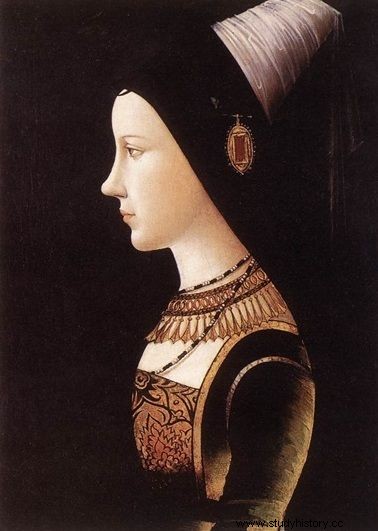
Małgorzata was only two years old when her mother, Maria Burgundzka, died in an accident (source:public domain).
Matrimonial castles
Maksymilian got bored of being a widower. He decided to change his marital status ... and his possession. He chose Anna of the Capetian lineage. The girl who was the last independent Duchess of Brittany. Marrying her would allow Maksymilian to successfully circumnavigate the French lands. The emperor did not mind that Anna Bretonska was only 3 years older than his daughter - what did it mean with the possibility of playing against competitors on the nose!
The reaction of the French, however, was much more decisive than he had expected. The long-distance relationship between the 31-year-old Habsburg and the 13-year-old Breton had infuriated Charles VIII to such an extent that he had armed Brittany and forced Anna to marry himself. Thus, the king of France broke two marriages and stole his wife from his mother-in-law ...
Although Charles no longer needed the little Habsburgian woman, he delayed giving her over to her former father-in-law, to whom he had no cause for sympathy. It was only after two years of detention that Małgorzata returned home, which she had never known before. And it was by no means a permanent return…
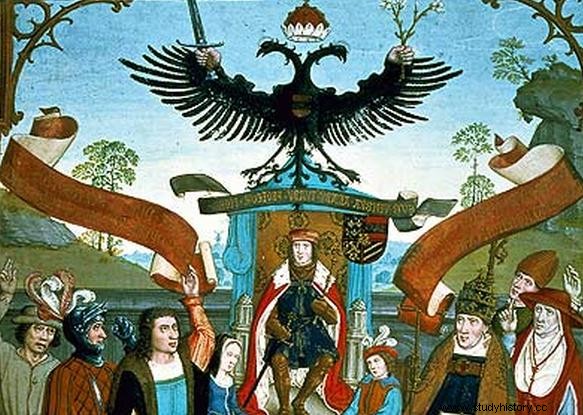
Emperor Maximilian Habsburg can hardly be called a good father (source:public domain).
Twice-married virgin
The growing up princess is, in a way, a hot potato. You must marry her when you are young or it will become a costly burden for the dynasty for the rest of your life. This was also the case with Małgorzata. As early as 1493, Maximilian began alliance talks with the kings of Spain. Two years later, the rulers reached a consensus, sealed by marriages between their children (of course, also at a distance for now). Filip Habsburg, son of Maksymilian, married Joanna from Spain, and our Małgosia - Joanna's brother, Jan.
The actual reunion of the spouses brought with it considerable challenges. The overland road was out of the question as it led through the territory of France against which the alliance was directed. It was hard to expect that Małgorzata's ex-husband (or fiancé) would idly watch her marry his ardent enemy.
Therefore, the sea route was chosen. First, Joan came to the Netherlands with a strong Spanish fleet, and then with the same convoy, Margaret set off towards her Iberian destiny.
During the voyage, she was terrified by a huge storm in the Bay of Biscay, which almost sank the ship. In this situation, sixteen-year-old Małgorzata shone with a dark sense of humor. She wrote a short, ironic epitaph:
Here lies Margaret, a good lady, sincere,
Although she is twice married, she dies of a virgin.
Too vulgar heir to the throne
It is hardly surprising. She sailed to meet her next husband and had every right to complain that both of her marriages were sham. Despite the obstacles, Małgorzata reached Iberian soil, enthusiastically received by her parents-in-law, and even more warmly by her husband. It was love at first sight, and it was difficult for Jan to be separated from his wife for a moment. So the virginity she had so regretted passed over her as he took his hand.
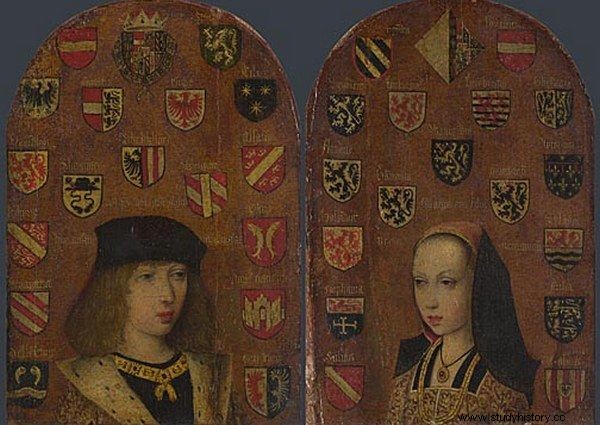
After the failure of the marriage with France, Emperor Maximilian decided that Philip and Margaret (in the picture) would marry the children of the Spanish king (source:public domain).
After all, the idyll did not last long. Three months after the wedding, John's health began to decline - he turned pale, weak and lethargic. Medics suspected that it was due to over-enthusiasm in the performance of marital duties. The parents of 18-year-old Jan were advised to keep the young away from each other for some time. The prince's mother, Izabela the Catholic, was to comment on this with the words:"What God has joined together, let no man separate".
Unfortunately, the advisers were right. At least in the fact that John's condition is very serious. The boy died six months after meeting Małgorzata for the first time. The princess was pregnant at the time, but gave birth to a prematurely dead baby girl.
The despair of the kings of Spain and the personal drama of Margaret, who lost the chance not only to become a queen, but also - a happy life with her friendly man, brought happiness to her brother's family. It was Jan's childless death that led the Habsburgs to inherit Spain. And thus:it completely upset the balance in European politics.
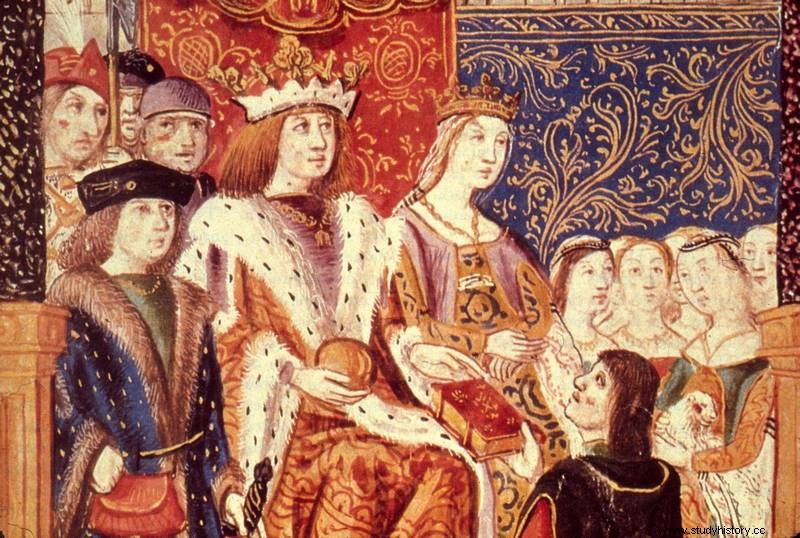
Izabela Kastylijska and Ferdinand Aragoński did not listen to their advisers and did not separate the young spouses (source:public domain).
Miss from recovery is back
Małgorzata returned to the Netherlands only two years after Jan's death. The death of Charles VIII, her first spouse, contributed to this return. The new ruler of France agreed to the passage of Margaret through his territory.
Considering the course of the previous turbulent journey, it is hardly surprising that Małgorzata did not want to return to the Netherlands by ship. She arrived in her country of birth just in time to become the godmother of her first nephew Charles, the future ruler of the "sunless empire".
Małgorzata spent only a year in the Netherlands. Even before her return, the father planned another, third marriage of his daughter. After all, she was still young (she was 20 years old), and moreover, she had proved her fertility. The Duke of Savoy became the new husband of Małgorzata. Unfortunately, this marriage was short-lived and childless.
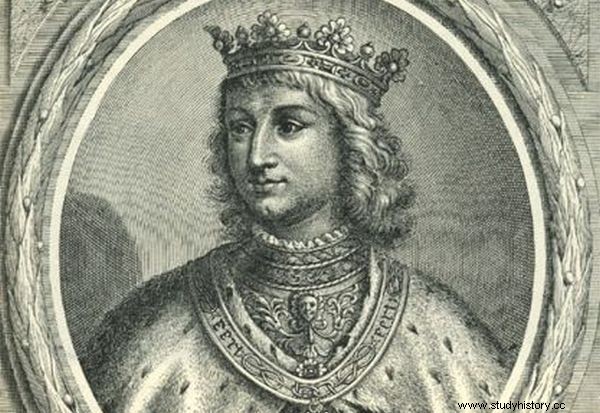
The third husband of Małgorzata was the Prince of Savoy, Filibert II the Beautiful. And this time, unfortunately, the marriage did not last too long (source:public domain).
A twenty-four-year-old, twice (actually three times) widow finally said enough. And she was against plans to marry her again.
If you are happy to be happy only in the Netherlands?
Małgorzata returned to the Netherlands again, but this time for good. As all her life circumstances had pushed her out of there, now they would hold her in place. Her brother died suddenly in Spain. In this situation, Małgorzata became the governor of the Netherlands. This office made her a great player on the European political scene for over two decades.
Four of her brother's children also went under the care of Małgorzata. In this way, she could feel at least partially a mother, despite the lack of her own children. As for other manifestations of love, Małgorzata's romance with an English nobleman, Karol Brandon, has gone down in history. However, the rowdy man did not stay with her long, abandoning Margaret for his younger sister Henry VIII.
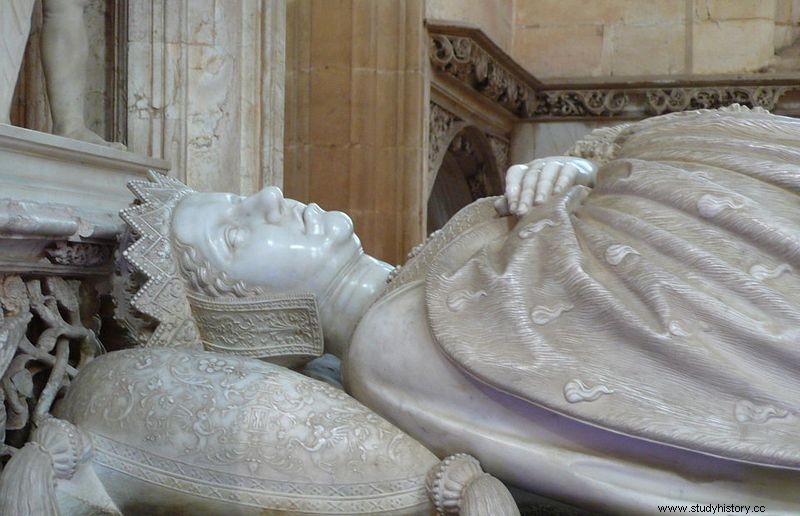
Małgorzata died at the age of only 50. She was buried in Bruges, but in 1532 her body was transferred to Brou, where she was buried next to her third husband (photo:Welleschik; lic. CC BY-SA 3.0).
Małgorzata died at the age of 50. For centuries, her biography has become a proof of the dangers lurking on the path of princesses, caught up in the nuances of dynastic politics. Although her humorous epitaph, delivered on the way to Spain, did not correspond to the actual state at the time of her death, it did not lose its timeless validity.
Princesses were still dying young, surviving partings with their families, marriages without feeling, and powerlessness in the face of fate. Looking at the matter from this perspective, perhaps it should be said that Margaret ultimately won the fight against dynastic destiny?
